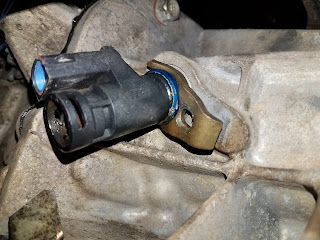The clutch pedal came in the mail and it looks pretty good. I decided to purchase the factory Ford style clutch master cylinder a while ago so I would have the factory setup that came on the transmission donor vehicle, which was a 1990 F150. In exchange for cheap and available parts down the road, I created the need to drill funky offset holes in the firewall and clutch pedal assembly. I will also be purchasing a universal adjustable push rod and clevis to connect to the pedal.
Step 1: Level the master cylinder in the vise and measure.
Step 2: Measure again and then drill the holes in the pedal bracket.
Step 3: Locate, measure, and mark the pedal assembly and master cylinder on the truck.
Step 4: Measure again and then drill the holes. I did not want to invest $25 in a specific size sheet metal hole bit that I would never use again, so I drilled out a circular hole pattern for the center hole, cut it through with a keyhole saw, and then filed down the rough edges with a rasp bit on the drill. I saved $25 and worked up a little sweat as a bonus.
Step 5: Mount the assembly. I used a motorcycle tie-down to hold the master cylinder in place while I fastened it from inside the cab. Also, its important not to forget to install the master cylinder mounting gasket to keep water and fumes out of the cab of the truck. I'm not saying that I forgot or anything, but if someone did forget, they would hypothetically have to get their wrenches back out, disassemble the stuff that they just finished assembling, put the gasket on there, then redo all of that work. That would be a real bummer if that actually happened, you know.
I reinstalled the passenger side front tire that was removed for engine hoist operations and lowered the truck down so it would be level. The transmission took a little over 3 quarts to fill using a cheap fluid transfer pump. It took like 800 pumps to get it all in there...
The heater bypass hose and cap were fit tested and look good. I'll have to cut the bypass hose down later.
SPECIAL DELIVERY! - not really, it was Amazon Prime on their normal schedule. My second set of headers arrived and I believe they are going to work. The lower primary tube on the driver side is hitting a bolt on the steering gearbox, but other than that, they look great. It won't take long to make the necessary modifications to get them installed. The second picture makes it look worse than it is due to the headers not being flush with the engine.
Here is a shot of the truck on all fours with a clean-ish garage floor.





















































